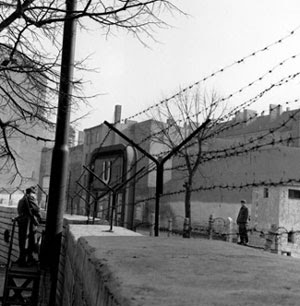 by Kathryn Hadley
by Kathryn HadleyWhat if Mitterrand’s alleged opposition to German unification was no more than a myth? Was Thatcher thus the only leader opposed to German unification? How far did Thatcher's views represent those of Britain as a whole? Maybe her alleged opposition to unification too was merely a legend? Or maybe these are the wrong questions to ask? If German unification was inevitable, perhaps the questions to be posed are slightly more complex.
These were some of the questions raised by an impressive panel of speakers at a conference held at the residence of the French Ambassador to the UK last week. The conference, entitled ‘France, Britain, German unification and European construction: Twenty years after the Fall of the Wall’, was organised to mark the launch of the latest book by Frederic Bozo,
Mitterrand, the End of the Cold War, and German Unification. Bozo is professor in contemporary history and international relations at the Sorbonne. Speakers included Bozo himself, Professor Michael Cox from the LSE, Professor Patrick Salmon, chief historian at the Foreign and Commonwealth Office, and Jean Mendelson, the director of the French national archives. The hugely engaging and stimulating discussion was chaired by James Blitz, the Diplomatic Editor of the Financial Times.
In his book, Bozo argues, against the dominant view, that Mitterrand was against German unification, and that he sought to oppose it. The French president’s alleged opposition was a ‘legend’. French policies were undoubtedly different to German and American policies and these differences, at times, caused disagreement between the three countries. Historiography is also dominated by the American viewpoint, which has caused French policies of German unification, in favour of a unified Germany within a European framework, to be largely overlooked.
Mitterrand was thus not opposed to German unification. According to Bozo, he was ‘intellectually ready’ and the German question was at the heart of French policies. He did not try to block German unification, but merely sought to slow down and control the process in order to embed it in a European framework. Bozo quoted Mitterrand: ‘German unification is legitimate provided it is done peacefully and democratically’. In Mitterrand’s opinion, German unification should not be a takeover, and should be compatible with international defence arrangements. Mitterrand may not have actively sought to oppose the unification process; however, is Bozo’s study not overly positive? Moreover, if Mitterrand was in favour of German unification, was Thatcher then the only leader who voiced her opposition?
Following his study of British diplomatic documents for his work on
Britain and German Unification 1989-90, Patrick Salmon was largely in agreement with Bozo: Mitterrand was in favour of German unification, albeit within a European framework. But, in his view, French opposition was not the only ‘legend’; British opposition was also a myth. Thatcher did not impede unification either, and he argued that there was a certain passivity about Thatcher and a fundamental gulf between her words and her actions. Her public rhetoric was, above all, ‘a way of letting off steam’ and the documents reveal how close British and French views were in reality. British and French views were divided primarily over Germany’s position in Europe. Another difference was that British diplomats had to work against the grain and wear down Thatcher’s opposition.
Neither Mitterrand, nor Thatcher, were thus opposed to German unification. The issue is, however, slightly more complex. The unification process was widely perceived as inevitable and, in this sense, it is unrealistic to think that Mitterrand or Thatcher would have publically opposed it. According to Michael Cox we are thus asking the wrong question. The question is not ‘did Mitterrand slow down the process of unification’. Indeed, in the face of the inevitability of German unification, it would have been an embarrassment to do so. Instead, the question should be: ‘was it reasonable for people to ask questions about a process that was already underway?’. A key issue was thus Gorbachev’s position within the process: would Gorbachev be brought down if the process got out of control? Was it important to keep Gorbachev within the unification process?
Finally, a key issue to consider is the extent to which Thatcher’s views were representative of those of British diplomats as a whole. What was Britain? With a strong leader such as Thatcher, there was a danger that her views obscured those of the policymakers who worked behind the scenes. Cox quoted a British draft paper on German unification to reveal an altogether different view to that publically voiced by Thatcher. The paper was admittedly only a draft; nevertheless, it stated that although there were ‘various disadvantages’ to reunification, ‘these aspects should not be exaggerated’ and ‘can be easily averted’. It argued in favour of unification provided that Britain could ‘exert influence over the speed and direction’ of the process.
Thatcher’s rhetoric was not just unrepresentative of British views in the Foreign and Commonwealth Office (FCO); Cox concluded that Thatcher’s attitude, in fact, put the FCO in a very difficult position: Thatcher was ‘embarrassing and complicating Britain’s position’.
In
After the Cold War: The Private Side of German Reunification, part of our short series ‘After the Cold War’ looking at changing attitudes to history in the former Communist states, Paul Betts considers the consequences of the collapse of Soviet Communism in eastern and western Germany.
In
The Berlin Wall: A Secret History Frederick Taylor asks whether the barrier between opposing sides of Berlin was more convenient to the Western democracies than their rhetoric suggested.
 http://www.daintyballerina.blogspot.com/ (Michael Power)
http://www.daintyballerina.blogspot.com/ (Michael Power)

 Che – Part One and Two
Che – Part One and Two 














